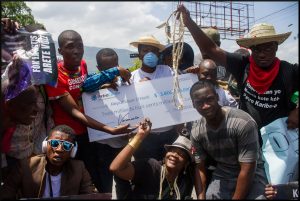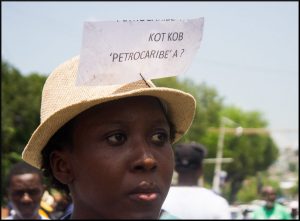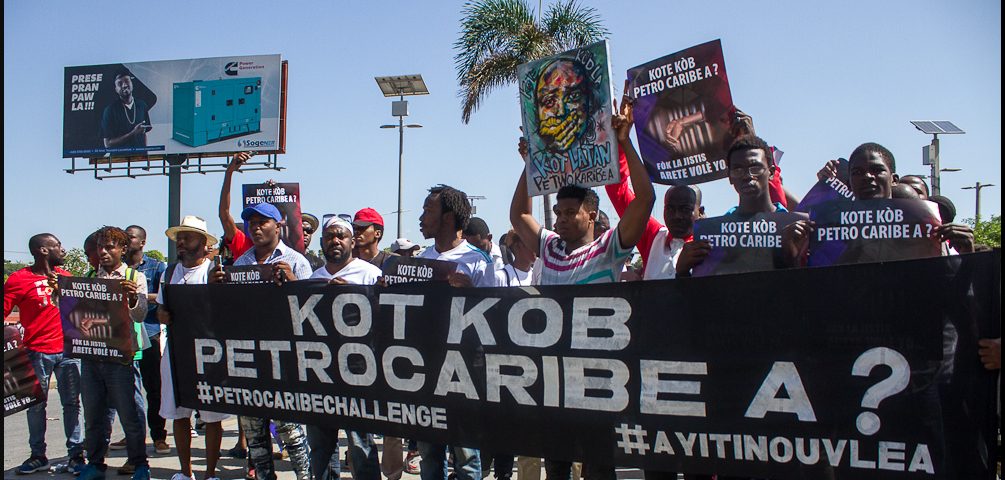Photo: On Sep. 2, hundreds marched through Port-au-Prince to ask where money from the PetroCaribe Fund had gone. ~Milo Milfort/Haïti Liberté
Protests over PetroCaribe Continue as Haitian President Seeks Imperialist Support
By John Marion , from World Socialist Website, 21 November 2018
For the second time in a month, thousands of Haitians took to the streets on Sunday to demand that the government come clean about embezzlement of PetroCaribe funds, and to call for the ouster of President Jovenel Moïse.
Tires were set on fire in the streets of Port-au-Prince, and rocks were thrown at the office building of Prime Minister Jean-Henry Céant. More than 3,000 police were deployed in the capital. As of Sunday evening, 11 people had been killed across the country, 45 injured and 75 arrested, according to protest organizers.
November 18 was chosen as a protest date because it was the anniversary of the 1803 Battle of Vertières, in which Haitian forces under General Jean Jacques Dessalines triumphed over French troops shortly before Haiti won formal independence.
Although Sunday’s protests were smaller than those held on October 17, they posed enough of a threat to Moïse that he did not travel to Cap-Haïtien for the traditional ceremony marking the day. Only a year ago, he used the occasion to announce the remobilization of the Haitian army, which had been disbanded in 1994 by Jean-Bertrand Aristide.
Haiti signed onto Venezuela’s PetroCaribe program in 2006. It is structured so that the Haitian government buys petroleum products on credit, sells them domestically, and then has 25 years to repay the Venezuelan government at very low interest rates. The funds retained by the Haitian government are supposed to be used for development and infrastructure projects. In reality, millions of dollars have been siphoned off by construction and energy companies in fraudulent schemes, or used for the purchase of police vehicles. Much of the corruption happened under President Michel Martelly, Moïse’s predecessor and mentor.
From the start of Haiti’s PetroCaribe participation through March 31, 2014, 29.4 million barrels of petroleum products were shipped from Venezuela to Haiti, and the Haitian government has reimbursed less than half the value. The growing protest movement has been demanding to know what happened to the rest of the money. Moïse has blocked Senate investigations into the question.
The Superior Court for Accounts and Administrative Litigation (CSCCA), which is in Moïse’s pay, also tried to stall investigations. However, it has done an about-face in response to the protests and is now promising an investigation to be completed in January.
The October 17 protests saw tens of thousands take to the streets across Haiti. Although a weekday, it was a holiday for workers because it marks the day when Dessalines was killed in 1806. Of the 10 departments in the country, only Nippes did not see large marches.

According to a report by the National Network for the Defense of Human Rights (RNDDH), three young protesters were arrested in the Martissant neighborhood of Port-au-Prince and executed in cold blood. Two journalists were threatened by police who fired their guns in the air and tried to confiscate a camera. A week later, on October 25, a protester was bludgeoned by the Haitian National Police for carrying a protest sign that depicted a replica of a check from the Venezuelan government to the Haitian government.
Eight people were killed on October 17. Two weeks later, on October 31, a funeral was held for six of the dead in the Port-au-Prince slum of Bel Air. The RNDDH report documents that Haitian National Police from the BOID (Brigade of Operations and Departmental Interventions) and UDMO (the Departmental Unit for the Maintenance of Order) were deployed outside. Funeral attendees threw stones and bottles and shouted that they didn’t need to be protected by the assassins themselves.
The police responded by firing their guns for 30 minutes, along with tear gas. While no one was hurt, panic filled the chapel and the funeral was delayed. As of November 9, two of the families still didn’t know where their children had been buried.
After the funeral, a march to protest the October 17 deaths was organized and it grew into a protest demanding information about the PetroCaribe corruption. During the march, one man was shot to death and at least eight others were injured by bullets.
There are also allegations that members of the BOID helped a gang leader called Ti Junior carry out a massacre in La Saline on November 13. More than 20 people were killed and their bodies left in piles of garbage on the street.
Moïse Jean-Charles, a former senator who ran unsuccessfully for president in 2016, has been seeking to divert the PetroCaribe protests into his Pitit Dessalines movement. His supporters have provocatively hoisted red and black flags in Cap-Haïtien and Port-au-Prince and carried them in marches. These colors were used by Dessalines before they were replaced with red and blue in 1806; the Duvalier dictatorship resurrected the red and black flag in 1964.
Jean-Charles ran on a program advocating political and economic sovereignty—particularly through making Haiti agriculturally self-sufficient—and a strong national government. In his biography, he boasts of his admiration for Fidel Castro, “whom on many occasions he had the privilege and honor of meeting.”

The United States and other imperialist powers are planning their next moves in response to the deepening crisis. US Ambassador Michèle Sison has met behind closed doors with the head of the two houses of parliament, while Prime Minister Céant met with Core Group representatives (from the UN, the OAS, the EU, France, Germany, Spain, Canada, Brazil and the United States) at the Canadian embassy. After violent protests in July against austerity measures, the Core Group haughtily declared that “while concerns about the difficulties of everyday life are legitimate, nothing can justify behaviors that may threaten…the safety of property, as well as the progress made in recent years in terms of stability and security and democratic progress in Haiti.”
President Moïse has met with the UN special representative for Haiti and with members of the country’s big bourgeoisie. Helen Meagher La Lime, the chief of the UN’s MINUJUSTH police force, met with Senate President Joseph Lambert, who tweeted afterward that “they recognized together the urgent necessity of reinforcing Haitian institutions that are too often broken.”
Céant was sworn in as prime minister on September 17, two months after the July protests led to his predecessor’s resignation. Since October 17, there have already been calls for Céant to fire cabinet ministers.
